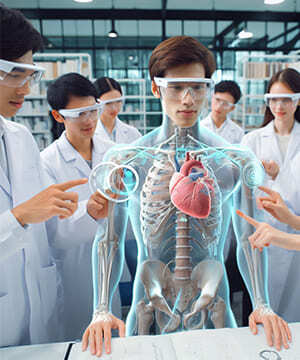Our project
Human Anatomy
This app uses augmented reality technology to provide an interactive and immersive learning experience about the human body. Users can explore different anatomical parts as 3D models that separate and highlight each section individually. By interacting with these models, users can see detailed labels and descriptions for bones, muscles, organs, and other components. This app is designed to enhance understanding of human anatomy through visualization, making complex structures easier to study for students, educators, and medical professionals alike. It combines education with technology to offer a comprehensive, hands-on approach to learning about the human body.

Augmented Reality Human Anatomy App
Need for the Program
Traditional anatomy education often relies on static images or physical models, which can limit students’ understanding of complex spatial relationships in the human body. This program addresses the need for an interactive and immersive learning tool that allows users to visualize and explore anatomical structures dynamically and intuitively.
1
Problems It Solves
* Overcomes limitations of 2D textbooks and static models by providing 3D, explorable anatomy.
* Reduces reliance on cadaver dissections, which can be costly, scarce, and ethically challenging.
* Enhances engagement and retention by allowing users to isolate and study individual parts in detail.
* Provides accessible education for remote or resource-limited settings.
2
How It Transforms Education
By leveraging augmented reality, the program transforms passive learning into an active, hands-on experience. Learners can manipulate and interact with different body parts, deepening their understanding of spatial anatomy. It promotes exploratory learning, critical thinking, and better memory retention through immersive visualization, potentially revolutionizing medical and biology education.
3
4
Key Importance
The program is a bridge between theoretical knowledge and practical understanding, making anatomy more accessible, engaging, and effective. It democratizes anatomical education, supports diverse learning styles, and paves the way for future innovations in medical training and patient education.
Augmented Reality Human Anatomy

Educational and academic leaders are encouraged to actively embrace and promote the use of this augmented reality anatomy program as a strategic tool for advancing science and education. Integrating such innovative technology can significantly enhance student engagement, deepen understanding, and improve learning outcomes in complex subjects like human anatomy.
Recommendations for Educational, Academic, and Scientific Leaders
Moreover, investing in and endorsing this program demonstrates a commitment to leveraging cutting-edge educational technologies, which can position institutions at the forefront of scientific education innovation. This proactive approach not only enriches current teaching methods but also prepares students for future challenges by developing their skills with advanced digital tools.













